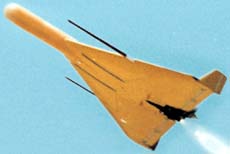Start < Page 1 of 11 >
Officially, Unmanned Combat Aerial Vehicles (UCAV) are still in early development, but such systems have already become important players in modern combat operations, primarily by US and Israeli forces operating in Low Intensive Warfare in the Middle East and Afghanistan. Other countries, including several NATO members, are also pursuing such capabilities.
 UAVs were first used in significant numbers during the Vietnam War, and later, in the Israeli invasion of Lebanon in 1982, but these were primarily reconnaissance platforms. The first lethal applications of UAVs were considered as “suicide missions”, utilizing the slow flying unmanned aircraft as precision guided ‘flying bombs’, which could loiter over enemy area for extended periods of time, in search of active radars or guided missile sites. During the late 1980s the first radar killer drone known as Harpy was developed under cooperation between IAI and Diehl, in a parallel program, another loitering weapon – the air-launched Delilah missile was developed in Israel by IMI. Few years later another, rather unique concept of combat drone was considered by the Israel Ministry of defense, during the early 1990s, immediately after the first Gulf war, when Israel was seeking a solution to counter the threat of ballistic missiles.
UAVs were first used in significant numbers during the Vietnam War, and later, in the Israeli invasion of Lebanon in 1982, but these were primarily reconnaissance platforms. The first lethal applications of UAVs were considered as “suicide missions”, utilizing the slow flying unmanned aircraft as precision guided ‘flying bombs’, which could loiter over enemy area for extended periods of time, in search of active radars or guided missile sites. During the late 1980s the first radar killer drone known as Harpy was developed under cooperation between IAI and Diehl, in a parallel program, another loitering weapon – the air-launched Delilah missile was developed in Israel by IMI. Few years later another, rather unique concept of combat drone was considered by the Israel Ministry of defense, during the early 1990s, immediately after the first Gulf war, when Israel was seeking a solution to counter the threat of ballistic missiles.
One such concept was the MOAB Boost-Phase Interceptor (BPI), which would have utilized a boosted version of the Python 3 air-to-air missile, launched by an unspecified stealthy High Altitude Long Endurance (HALE) UAVs operating deep over enemy territory. While Moab never reached even demonstration stage, Israel has not abandoned this concept and, according to foreign sources, deployed a full scale UAV centric BPLI system for the first time during the 2006 Lebanon war, in an attempt to hunt medium range rocket launchers used by the Hezbollah to attack targets in Israel. While the system did not succeed in eliminating the illusive short range rockets, the effectiveness, life span, and survivability of long and medium range rockets launchers was dramatically reduced as the war progressed.
The concept of an armed UAV was publicly outlined in 1996, as the US Air Force Chief of Staff directed the study “UAV Technologies and Combat Operations”, recommending testing and developing weaponized versions of high flying UAV, particularly for Supression of Enemy Air Defense (SEAD) operations. During allied operations in Kosovo, UAVs were supporting strike packages to locate time-critical targets. Such targets were identified and confirmed using the TV payloads carried by General Atomics RQ-1 Predator UAVs.
However, targets frequently eluded the aerial strikes, due to the delay between the target detection, attack preparation process (targeting) and the actual execution of the attack. Essential improvements applied on UAVs just after the operation in Kosovo included the integration of laser designator in the standard EO/IR UAV payload. Work on a weaponized version of the Predator commenced, culminating in a series of test firings of Lockheed martin Hellfire missiles from USAF Predator UAVs in 2001. These platforms were later flown by the CIA and already demonstrated dramatic results during operations in Iraq, Afghanistan and Yemen. CIA operated Predators were credited with the elimination of senior Al-Qaeda operatives and Taliban fighters in 2002. Another example for an early generation armed UAVs is the Nothrop Grumman / IAI MQ-5A Hunter, an armed derivative of the RQ-5A UAV. This aircraft was also fitted with an extended wing, carrying hard-points for two weapons such as Hellfire or Northrop Grumman Viper-Strike munitions. The General Atomics Gnat UAV is also designed to carry Hellfire missiles.
Read additional parts of this article:
- Smart Weapons for UAVs
- Weaponized UAVs
- Smart Weapons for UAVs
- Evolution of UAV Employed Missiles
- Lightweight Weapons for Autonomous Platforms
- Gravity Dropped Munitions for UAVs
- Targeting at the pixel
- Loitering Autonomous Weapons
- Grouping in Constellations
- Empowered by the Swarm
- Weaponizing Unmanned Combat Helicopters

















